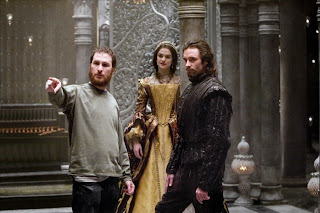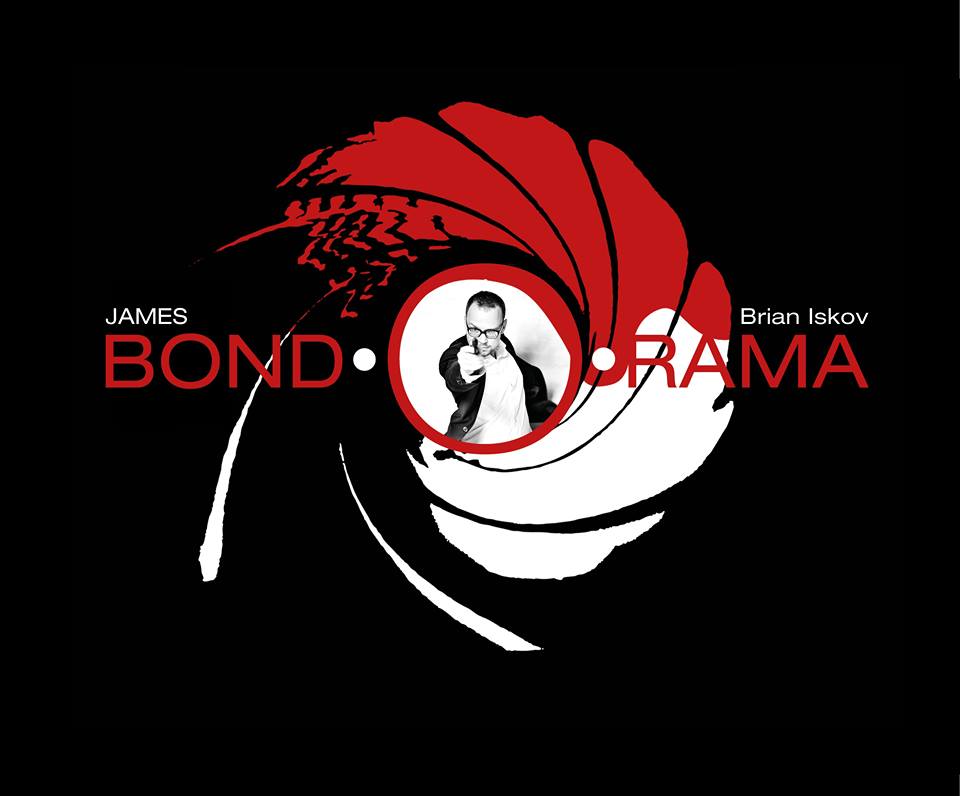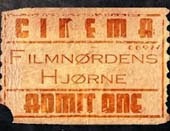 |
| Hugh Jackman & Rachel Weisz i "The Fountain" (2006) | 20th Century Fox |
Jeg oplevede filmen første gang ved dens verdenspremiere i Venedig, og jeg hørte til det absolutte mindretal, der følte sig berørt af "The Fountain" og så den som en organisk, dybfølt og tænksom meditation over livet og døden. Det hjalp selvfølgelig også, at jeg dagen efter havde en halv time med Darren Aronofsky på Hotel Excelsior, hvor han beredvilligt og pædagogisk forklarede hele filmen for mig!
(I øvrigt mødte jeg Aronofsky i selvsamme balsal, hvor middagsscenen i Sergio Leones "Once Upon a Time in America" er optaget - hvilket Aronofsky ikke var sen til at påpege med slet skjult nørdet begejstring. "Strukturen i "The Fountain" er i høj grad inspireret af "Once Upon a Time in America", fortalte Aronofsky mig.)
For foreign readers: The following is my previously unpublished interview with Darren Aronofsky from the Venice Film Festival 2006, in which he talks in depth about his ideas behind "The Fountain".
DARREN ARONOFSKY EXPLAINS "THE FOUNTAIN"
As told to Brie at Venice Film Festival, September 2006
Previously unpublished
WHAT'S IT ALL ABOUT?
I think that "The Fountain" is a fairy tale. It's "Once upon a time, happily ever after." It's magical. But I like to call it a psychedelic fairy tale, because that means that it's a little more adult. Because it is, it's not for kids. It's a mature fairy tale, but really, that's all it is. It's two people deeply in love who are gonna lose each other, and how will they be back together.
DEVELOPING THE SCRIPT
How it all evolved is a long story. We [Darren Aronofsky and co-writer Ari Handel] started writing "The Fountain" in 2000 and put together a big 75 million dollar version of it. In September 2002, when we were seven weeks out and had spent 18 million dollars, the lead actor [Brad Pitt] quit, and the film fell apart. They wrapped up the sets, I went home, and for about seven months I tried to figure out what to do next, and I started to come up with new ideas.
 |
| Darren Aronofsky, Rachel Weisz & Hugh Jackman on set | 20th Century Fox |
I rewrote it. And about two weeks later, I finished the script and handed it to my producer, and he said, "You know what? You've turned it from a story into a poem. And we can make it for 30 million dollars."
 |
| Hugh Jackman i "The Fountain" (2006) | 20th Century Fox |
IZZI'S BOOK AND THE INQUISITOR
So Izzi in her generosity, realizing that she can't reach him, decides to make a gift for him. And she writes a book that basically is a metaphor for their experience, and what's going on. It's about a conquistador who is kind of the cliché of the man overcoming everything. They were pretty vicious guys, you know, stealing the gold, doing anything for wealth and country.
 |
| Hugh Jackman & Rachel Weisz i "The Fountain" (2006) | 20th Century Fox |
Then Izzi dies, and Tommy's left with an unfinished book, which is really the ultimate gift. It's not a finished book, you have to figure out how this ends. How do you get past the Mayan priest? How is the Conquistador gonna solve the problem? Because it looks like the Conquistador has died, which we saw at the beginning of the film. So Tommy puts it on the back shelf and starts following his invention of living forever.
And we cut forward deep into the future, and you get to the future story, which is our man 500 years later, or 300 or 100 years later, whatever it says in the press package. I think the studio was trying to make sense out of it for themselves. But that doesn't matter. For me, it's just a man so deep in the future that you don't recognize [it].
 |
| Hugh Jackman i "The Fountain" (2006) | 20th Century Fox |
DESIGNING THE FUTURE
It's funny, because when we started working on the science fiction [elements of this story], we didn't want to do the old sci-fi. Since "2001: A Space Odyssey", even before, every single movie that has come out just stick these floating trucks and cars in space. There's absolutely no reason that spaceships should look like trucks and cars. There was a movie, "Buckaroo Banzai" (1984), which had an organic shape, which was kind of cool. But mostly, they just look like the same thing we have now, which doesn't make any sense.
So we started thinking about, what kind of shape would the ship take. And we though about a cube ... We started simplifying, and eventually we went for the most simple shape, which was a sphere. Then we got to the bubble idea, because we thought, you're shooting through space - what do you wanna do? It's about the view!
 |
| "The Fountain" (2006) | 20th Century Fox |
And the story's not about that, it's about a guy trying to stay alive inside this ship that he's taking and following Izzi's instructions to take this dying tree, that he's been killing by eating, to be reseeded and rebirthed when Xibalba dies, this dying star that she talks about.
Did anyone get any of this? It's all there, right? But it's told not in the most obvious way, because we wanted to respect audiences.
RESPECTING THE AUDIENCE
There is the argument that people go to see movies one time. This is not one of those movies. We worked hard on "The Fountain" trying to make something that will stick around for a while. We really wanted to build this Chinese box, or these Russian dolls that go inside each other, of all these mysteries of what the film is.
 |
| Hugh Jackman i "The Fountain" (2006) | 20th Century Fox |
Certain films that will remain unnamed are disposable commodities, there for the instant, and then, a few years down the line, you don't really hear about them anymore. "Requiem for a Dream", people are still watching [that one]. I meet all these teenagers that are still discovering it.
Sting came to see the movie, and he really dug the film, but he was like, "People are gonna fucking hate your movie". And I said, "Why?". And he said, "Because they are so holding on to what they want to believe, that if you start shaking it up in any way, they're just gonna get really angry. They are not gonna want to hear it." I'm excited for that.
HOW WE HANDLE DEATH
There are certain cultures, certainly in the past, where it has been more incorporated into life. But now, in the West, all we try to do is to run away from death.
 |
| Hugh Jackman i "The Fountain" (2006) | 20th Century Fox |
We've just completely brainwashed ourselves. As a kid, I remember my parents not taking me to funerals, to try and keep me away if an uncle would die. It's really gotten bent out of shape. Whereas in New Orleans, they play trumpets and dance in the streets. In Ireland, they have a party with kids.
THE MORAL OF THE STORY
I think we choose our fate. Tom at any point could have chosen to join Izzy in finding peace and not be chasing life. But he fights it. The only fate we have is that we have to go through the struggle so that we can get to that choice. Because I think we're all learning along the way.
 |
| Hugh Jackman & Rachel Weisz i "The Fountain" (2006) | 20th Century Fox |
> Listen to Darren Aronofsky's self-made commentary track for "The Fountain"
> Darren Aronofsky reflects on the box office failure of "The Fountain" (Bullett Media)


